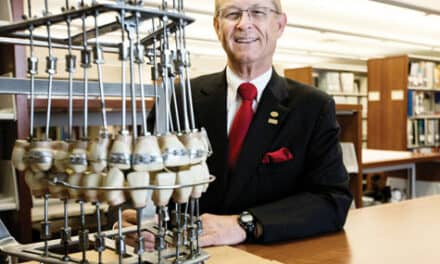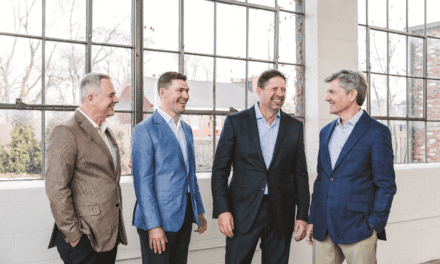by Rich Smith
Orhan C. Tuncay, DMD, brings the future of orthodontics from academia to private practice
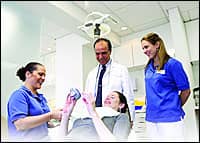
So, for Tuncay—chairman of the Department of Orthodontics at Philadelphia’s Temple University—the only other way to inspire people to hasten themselves to the orthodontic-clinic door is by developing the means to move teeth with biological agents. Toward that end, he and his Temple University research colleagues are currently busy evaluating a number of possibilities, including the use of the female hormone relaxin.
“Relaxin causes a woman’s hip sutures to loosen just before childbirth so that her baby can more easily pass through the birth canal,” says Tuncay (pronounced TOONJ-eye). “The idea is to use this hormone to see if we can induce teeth to move faster and stay in place better and longer. One of my former residents, Jonathan Nicozisis [DMD, MS], who now is in practice in Princeton, NJ, came up with the idea after he noticed that women close to the time of delivery would complain of loose joints and inflamed gums. He thought it might be possible to harness this response of the body as a means of improving orthodontic treatment.”
The work with relaxin is only in the animal-studies stage, and Tuncay indicates it may yet be a while before human testing takes place. Meanwhile, he has a second biological strategy under exploration. The agent: nitric oxide. “We know that nitric oxide affects the vascularity of periodontal structures around the teeth,” Tuncay says. “Accordingly, we are trying to develop the techniques for increased nitric oxide synthesis of the areas where tooth movement is desired. Again, our expectation is that this will result in faster movement of the teeth, with superior holding characteristics.”
Tuncay hastens to caution that it is far too early to become excited about the prospects of relaxin and nitric oxide as treatment accelerators. He has seen an innovation look good on the drawing board but fall short when translated into an actual product or modality enough times that he doesn’t allow himself to grow overly enthusiastic. Take ultrasound, for instance. “We had hopes that ultrasound waves could affect the rate of tooth movement,” he says. “That didn’t pan out in clinical testing. But we haven’t abandoned the concept. We think we know what the problem was, and we’re currently working toward a solution.”
|
||||||||||||||||||||
The Freedom of Private Practice
If any of these ideas do show promise enough to merit a clinical trial, it’s a sure bet that one of the study sites will be Tuncay’s own private-practice office, Rittenhouse Orthodontics, launched in early 2004 and located a short distance from the Temple campus (where Tuncay also serves as graduate program director). “I see 30 patients per day between 10 in the morning and 6 in the evening, which is a good, relaxed pace for me,” he says, clarifying that he is in the private-practice office but 1 day per week. “Temple has a rule that prohibits faculty from devoting more time than that to off-campus private-practice activities.”
Tuncay explains that he started Rittenhouse Orthodontics to overcome the deficiencies he found inherent in maintaining an on-campus academic practice. “It was too limiting to my ability to attract what I felt was an adequate number of patients,” he says. “Also, because the staff was provided by the school—as were the supplies—I did not have as much freedom to choose exactly what I wanted in the way of personnel and materials. On top of all that, the university controlled the overhead, which left me with a lot less take-home income than I would have had were I able to make my own decisions about costs.
“By contrast, private practice has been a wonderful, extremely satisfying experience. I’m able to see more patients. I hire the people I want to hire. And I have full control over my overhead. As such, my income potential is remarkably better. I once calculated that an academician working in private practice 1 day per week can earn double or triple what his university pays him for the other four days.”
The Academic Edge
Being an academician in private practice carries with it other advantages, Tuncay acknowledges.
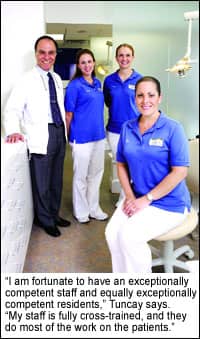
Although the academic nature of Tuncay’s practice gives him a leg up over the nonacademics around town, that edge is not nearly as sharp as one might expect. “We’ve conducted fairly extensive research on the marketing of orthodontic practices to understand why people choose the practitioners they do,” he says. “The data reveal that people don’t shop for an orthodontist who is an academician. Rather, what they do is compile a list of several orthodontists from around their neighborhood as candidates for consideration. Only when they evaluate the credentials of the practitioners on their list does being an academician, someone who teaches orthodontics, become a factor that favors that orthodontist above all the others.”
The Adults-Only Office
In addition to his 1,800-square-foot off-campus facility, Tuncay maintains a 900-square-foot satellite office in a blue-collar part of the Philadelphia suburbs. He spends a total of 2 days per month in that outpost.
“My satellite was opened after a husband-and-wife dentist team invited me to their office to start seeing some of their patients,” he says. “So, I rented an office right next door to them.”
The satellite, by dint of being in the suburbs, treats mainly children and depends heavily on insurance reimbursements. On the other hand, the Rittenhouse flagship sees only adults. “That’s because almost no kids live in the sprawling business district, which is where my main office is located,” Tuncay explains.
Given that adults bear little love for conventional braces, Rittenhouse offers clear aligners only. He is highly expert in the use of aligners—not surprising, since Tuncay was among those who had a hand in developing a popular system of clear aligners. And, earlier this year, he authored The Invisalign® System (published in Germany under the Quintessence imprint), the world’s first textbook on that modality. Says Tuncay, “It’s not a how-to manual; it is a classroom reference work that is intended to enlighten knowledge-seekers about the material properties and mechanics of Invisalign.”
By no means does this textbook represent Tuncay’s first foray into writing. A decade ago, he was the founding editor of four different periodicals: Orthodontics & Craniofacial Research (published in Britain and Denmark), Progress in Orthodontics (published in Italy by the Societa Italiana Di Ortodonzia), Cases & Commentaries in Orthodontic Technology, and Clinical Reports & Techniques (a journal about using clear aligners). Within the past year, Tuncay passed on the ink-stained baton to others. “Being an editor on top of everything else was very difficult; my weekends were almost completely taken up with that role,” he says in explaining why he decided to stop working on those publications.
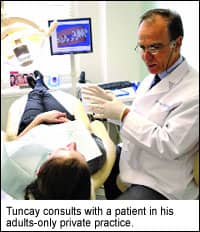
Tuncay is supported in his practice by two chairside assistants, an office manager, and varying numbers of residents under his tutelage. “I am fortunate to have an exceptionally competent staff and equally exceptionally competent residents,” he says. “My staff is fully cross-trained, and they do most of the work on the patients. In the intramural settings of other universities where I had worked, I used to do everything, which I felt made little sense from either the conceptual or practical standpoints.”
Thanks to this support team (and to his decision to give up the editorships), Tuncay now has time enough to squeeze in a few recreational pursuits. Among those are bicycling and movie-going. “Recently, I took up clay-pigeon shooting,” he adds.
Delightful though those activities might be, it’s research that truly captures Tuncay’s fancy. Some of his greatest contributions on that front have been in the realm of imaging technology, as evidenced by the fact that he holds a number of patents for 3D imaging software. “The beauty of 3D imaging is it allows the orthodontist and the patient to see what is going to happen as a result of the proposed course of treatment,” he says. “In my opinion, the most dangerous thing a practitioner can do is allow patients to fantasize for months and months and months about what they will look like at the end of treatment and then have a result that is not very much like what they built up in their head. An animated 3D image—whether in the form of Invisalign images or 3D facial images—helps manage expectations and avoids disappointment at the end of treatment.”
Getting Started
Tuncay was born in Turkey (where he completed dental school before coming to America in 1970 at the age of 23), and his first job was with the University of Pennsylvania as a research associate in the dental school’s department of biochemistry. After a time there, he decided to make a career for himself in orthodontics, a decision that prompted him to begin orthodontic residency at the University of Pennsylvania.
He later taught at the University of Kentucky and went on to become chairman of its department of orthodontics. He was then chairman of the orthodontic department of The University of Mississippi. From there, he entered his current relationship with Temple University.
In addition to his academic titles, Tuncay holds leadership positions in several professional societies. These include chairman of the AAO’s Council on Scientific Affairs, president of the Greater Philadelphia Society of Orthodontists, and president of the Craniofacial Biology Group of the International/American Association for Dental Research. A diplomate of the American Board of Orthodontics, Tuncay also is a fellow of the College of Physicians of Philadelphia and a member of the Angle Society of Orthodontists (not to mention an honorary member of the Charles H. Tweed Foundation). The AAO, by the way, annually awards a fellowship named in his honor to the resident who most embodies Tuncay’s ideals about the future of the profession.
A Better Mousetrap
For a glimpse of that future, one need only have a look at Tuncay’s main office. What becomes quickly apparent is that next-generation orthodontic offices will likely be designed with far greater emphasis on function, although not necessarily at the expense of aesthetics.
“If you ask me what it takes to have a superbly functional orthodontic office, the first thing I’ll tell you is it must have a reception and waiting area designed to facilitate good traffic flow,” Tuncay offers. “It should be as convenient as possible for the staff to walk from the clinic area, go into the waiting room and summon the patient, then escort the patient back to the clinic area. An efficient solution is to use electronic systems to page the waiting patient when it’s his or her turn to come into the clinic.”
As for the clinic, Tuncay believes the layout in that area should strictly suit the orthodontist’s and staff’s convenience and comfort. “Clinical spaces also must be designed to be as high-tech as possible—but, at the same time, computers should be as low-key as possible with regard to visibility; it’s not psychologically pleasing to have computers and other high-tech toys crowding you. You should strive to achieve what the Chinese call feng shui, which refers to an atmosphere that makes you feel good about being in a place because everything is so well harmonized.”
Tuncay’s office was designed by his wife, architect Agnes Kan, who specializes in this type of project. His practice acquired the name Rittenhouse Orthodontics before the office he currently occupies was built. “Initially, I rented space from a colleague whose office was on Rittenhouse Square,” Tuncay reveals. “And, frankly, giving my practice the name Orhan C. Tuncay, PC, was not as alluring-sounding from a pure marketability perspective as calling it Rittenhouse Orthodontics.
“Also, thinking ahead to my retirement, I knew it would be much easier for whoever buys my practice to transition into ownership of it if the name were Rittenhouse Orthodontics as opposed to being just my name.”
This demonstrates that Tuncay is truly a builder of better mousetraps—and not just those intended to move teeth faster and better. It’s why the world is beating a path to his door.
Rich Smith is a contributing writer for Orthodontic Products.


